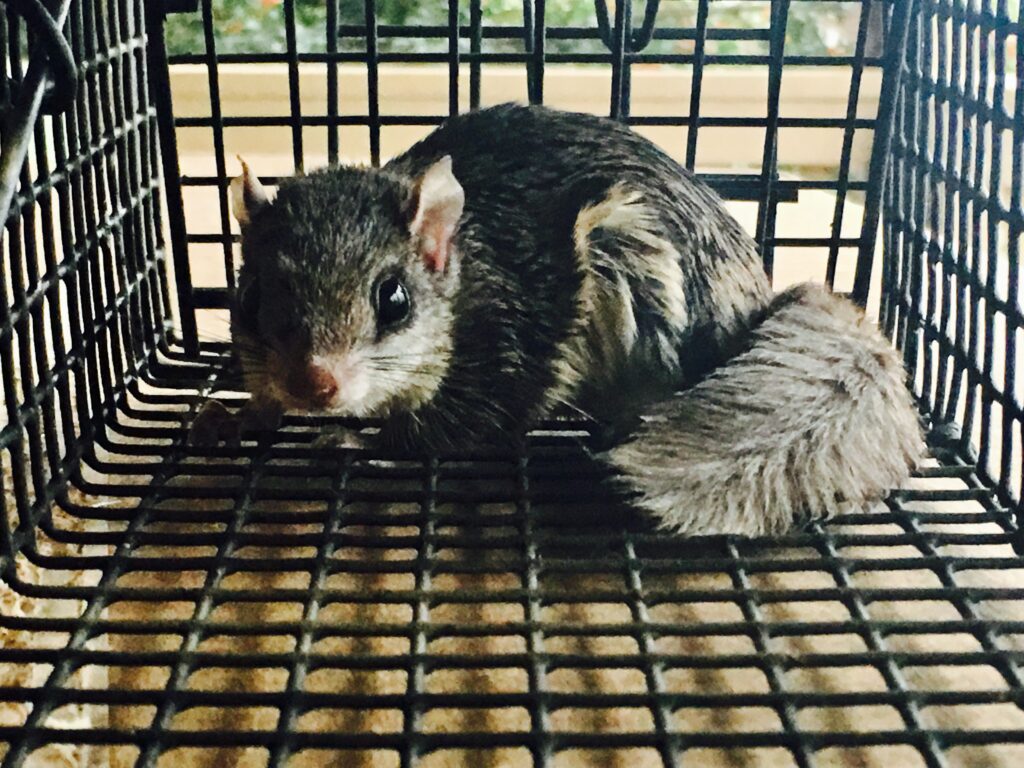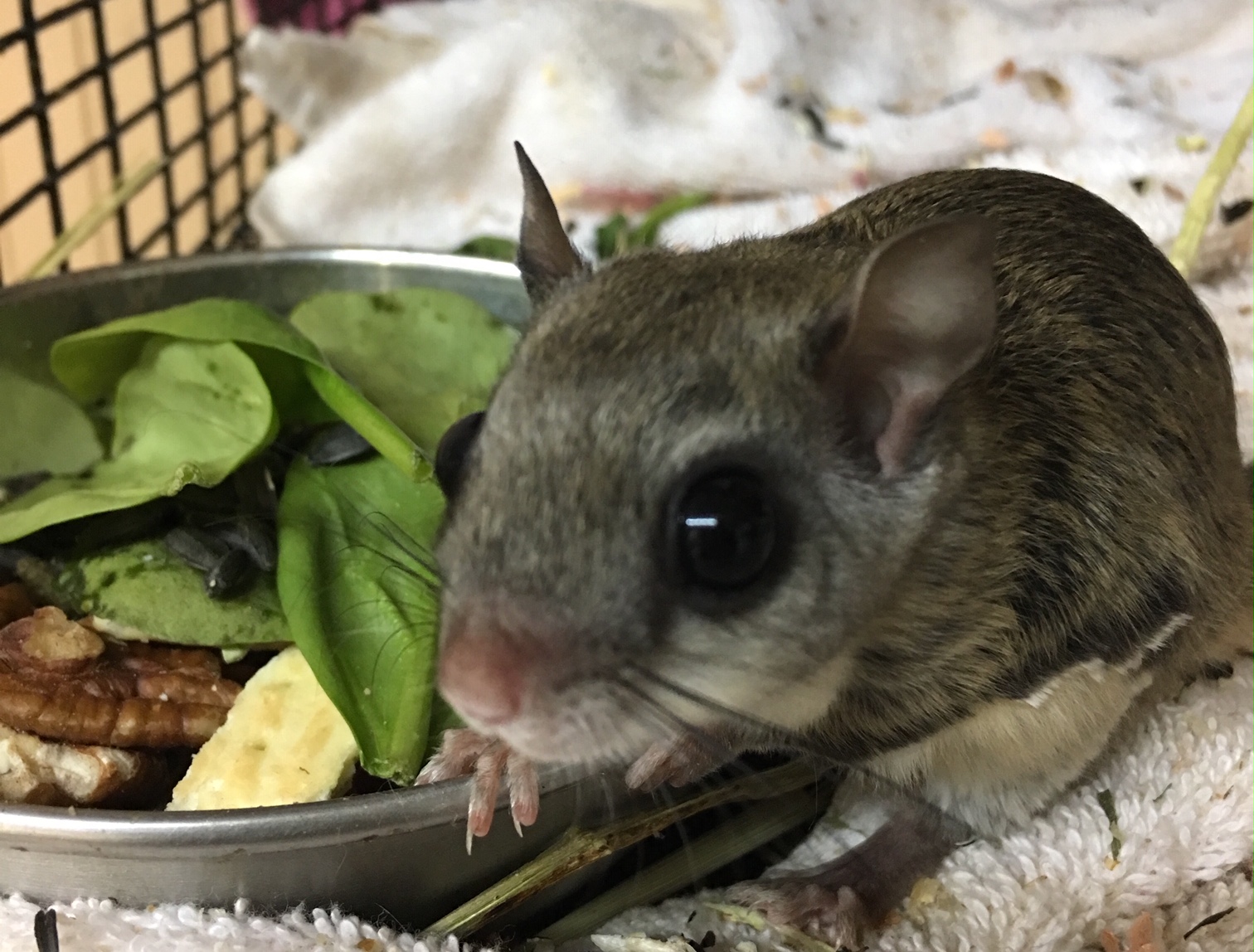The stealthy nocturnal wonders, the southern flying squirrels, might just be the most intriguing visitors your attic has ever had. Found throughout regions like North Georgia, they remain a mystery to many due to their elusive nighttime habits. As a leading wildlife control company with over 15 years of experience in the North Metro Atlanta market, we’re here to shed light on these fascinating creatures and guide homeowners in peaceful coexistence.
A Closer Look at the Southern Flying Squirrel:
Small in size but big in wonder, southern flying squirrels weigh just 2 to 3 oz. and measure between 8 1/2 to 9 7/8 inches. Their lustrous reddish-brown to gray fur contrasts with a creamy white belly. But it’s their unique gliding membrane, stretching from wrist to ankle, that truly sets them apart. This, coupled with a tail that acts as a stabilizer, enables them to glide gracefully between trees, covering distances of up to 200 feet.

Why the Attic? Habitat and Behavior Insights:
These squirrels naturally prefer hardwood and mixed pine-hardwood forests, especially older trees with cavities for nesting. However, the warmth and safety of human-made structures like attics can be enticing. They are known to occupy cavities as large as those made by woodpeckers, customizing entries between 1 1/2 to 2 inches in diameter to fit their needs. In winter, it’s not uncommon to find them roosting in surprisingly large numbers.
Though nocturnal, their presence can sometimes be heard, more so than seen. Scratching, soft chirping, or scurrying in walls or attics are indicative of their presence. Sometimes the only way to know there is an issue with critters in your attic is by the signs or damage left behind such as tunnels, divots and nuts, acorns and debris.
The Challenge and Solutions for Homeowners:
Understanding the issue is the first step. Flying squirrels seek out attics for warmth, shelter, and proximity to food sources. Here’s how to address the intrusion:
1. Proper Identification: Before jumping to conclusions, identify your invaders. While you may not see them due to their nocturnal habits, listen for telltale signs like scratching or soft chirping.
2. Wildlife Exclusion: We, as a Professional Nuisance Wildlife Control Company with over 15 years of successful wildlife exclusion can provide you with an estimate to seal a home using critter-proof materials in a manner which is designed to keep wildlife out. Our expertise ensures even the most persistent flying squirrel can’t gain entry into your walls or attic.
3. Habitat Modifications & Adjustments:
a) Trim trees close to your home. This reduces access points and makes it harder for them to glide onto your roof.
b) Remove bird feeders which is notorious for attracting all sorts of unwanted wildlife.
4. Humane Trapping and Relocation: In our vast experience, homeowners seldom spot these creatures until they’re safely in one of our traps. We specialize in humane relocation, ensuring they find a more suitable habitat away from human residences. Just ask us about our Humane Flying Squirrel Trapping Services.
5. Regular Checks: Especially in colder months, it’s essential to routinely inspect your attic and surroundings. Their preference for tight spaces and warmth makes attics an ideal spot.

Southern Wildlife Management’s goal is to foster understanding between humans and the creatures we often find ourselves living alongside. The Southern Flying Squirrel, with its rich history and intriguing behaviors, is just one of many wildlife species that homeowners may encounter. With the right knowledge and preventative measures, peaceful coexistence is more than possible. As long as the meaning of coexisting means we live in our homes and they live out in nature where they belong.
Physical Attributes:
- Appearance: Distinct reddish-brown or gray fur, contrasted by a creamy white belly.
- Size: Typically measures between 8 1/2 to 9 7/8 inches, inclusive of a 3 to 4-inch tail.
- Weight: Usually weighs between 2 to 3 ounces.
Unique Features:
- Gliding Membrane: This squirrel possesses a “cape” of loose skin from its wrists to ankles, forming a gliding membrane bordered in black. This allows it to glide considerable distances, often with impressive agility, adjusting its course even at sharp angles.
- Sounds: They can produce bird-like chirps, with some vocalizations beyond human hearing.
Habitat & Behavior:
- Habitat Preference: Prefers hardwood and mixed pine-hardwood forests. Needs older trees with cavities for nesting and roosting.
- Roosting Habits: Known to roost in large numbers, with as many as 50 in a single tree cavity.
- Gliding: Their most iconic behavior. Instead of flying, they glide from tree to tree, even covering distances of up to 200 feet.
- Nesting: They favor cavities in hardwood trees, with nests lined with finely chewed bark, grasses, lichen, moss, and feathers.
Diet:
- Omnivorous in nature.
- Stores hard mast like nuts and acorns.
- Also consumes fungi, berries, fruits, flower blossoms, bird eggs, and even animal carcasses.
Human Interaction:
- Their nocturnal nature makes them elusive, but they often reside in nest boxes in suburban areas, especially near deciduous trees. They are also attracted to bluebird boxes.
Did You Know?
- Their tail functions more like a stabilizer rather than a steering instrument during flight.
- Unlike bats, they do not use echolocation for navigation. They do, however, vocalize in the ultrasonic range, possibly for close-range communication.
- Flying squirrels have existed for over 30 million years, making them the oldest living lineage of “modern” squirrels.
Life Cycle:
- Breeding: Typically breed twice a year, in January-February and June-July.
- Offspring: Can give birth to between 1 to 6 young, though usually 2 to 3.
- Growth: The young can glide at 8 weeks and stay with their mother until her next litter.
- Lifespan: They can live up to 13 years in captivity, but usually only up to 5 years in the wild due to predators like owls, hawks, and snakes.
